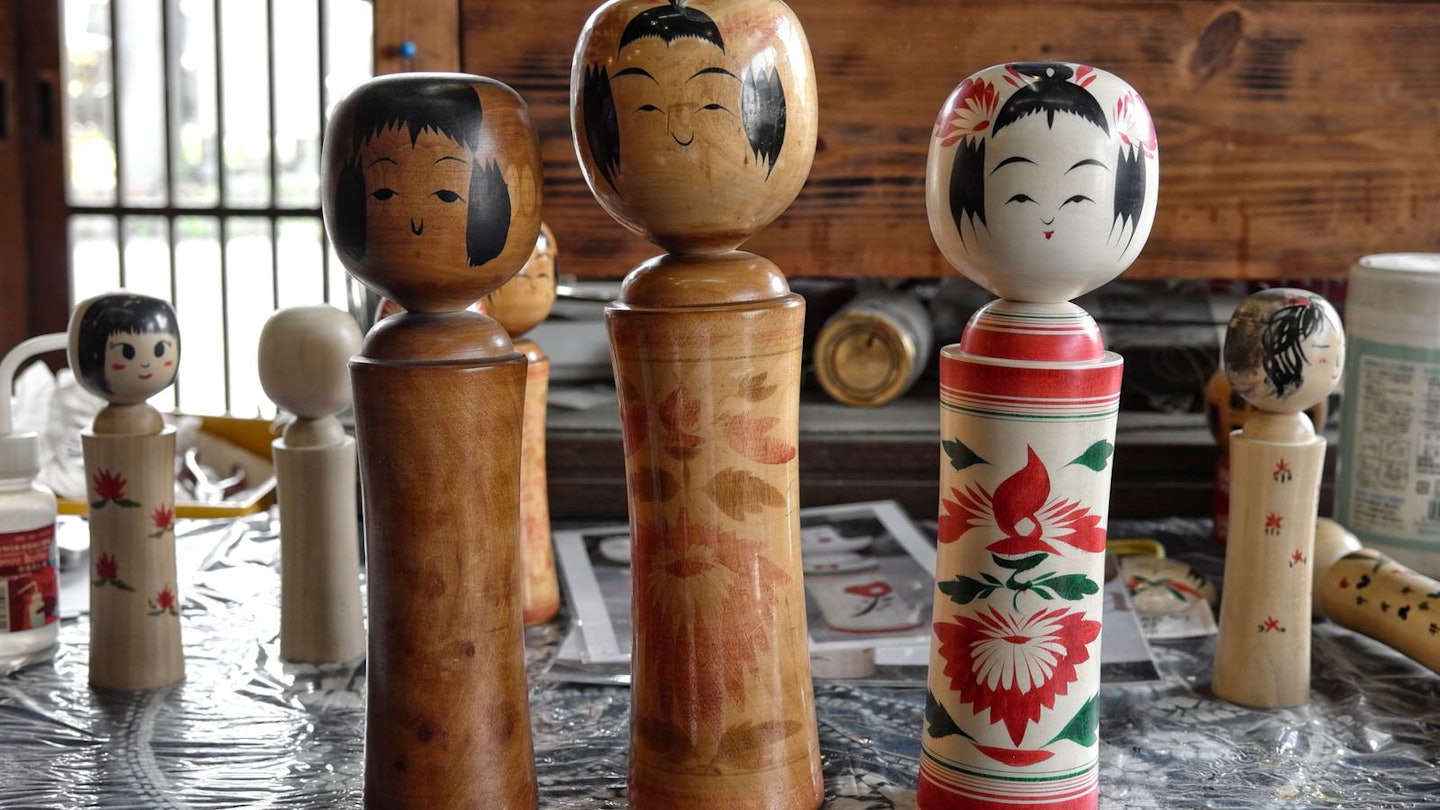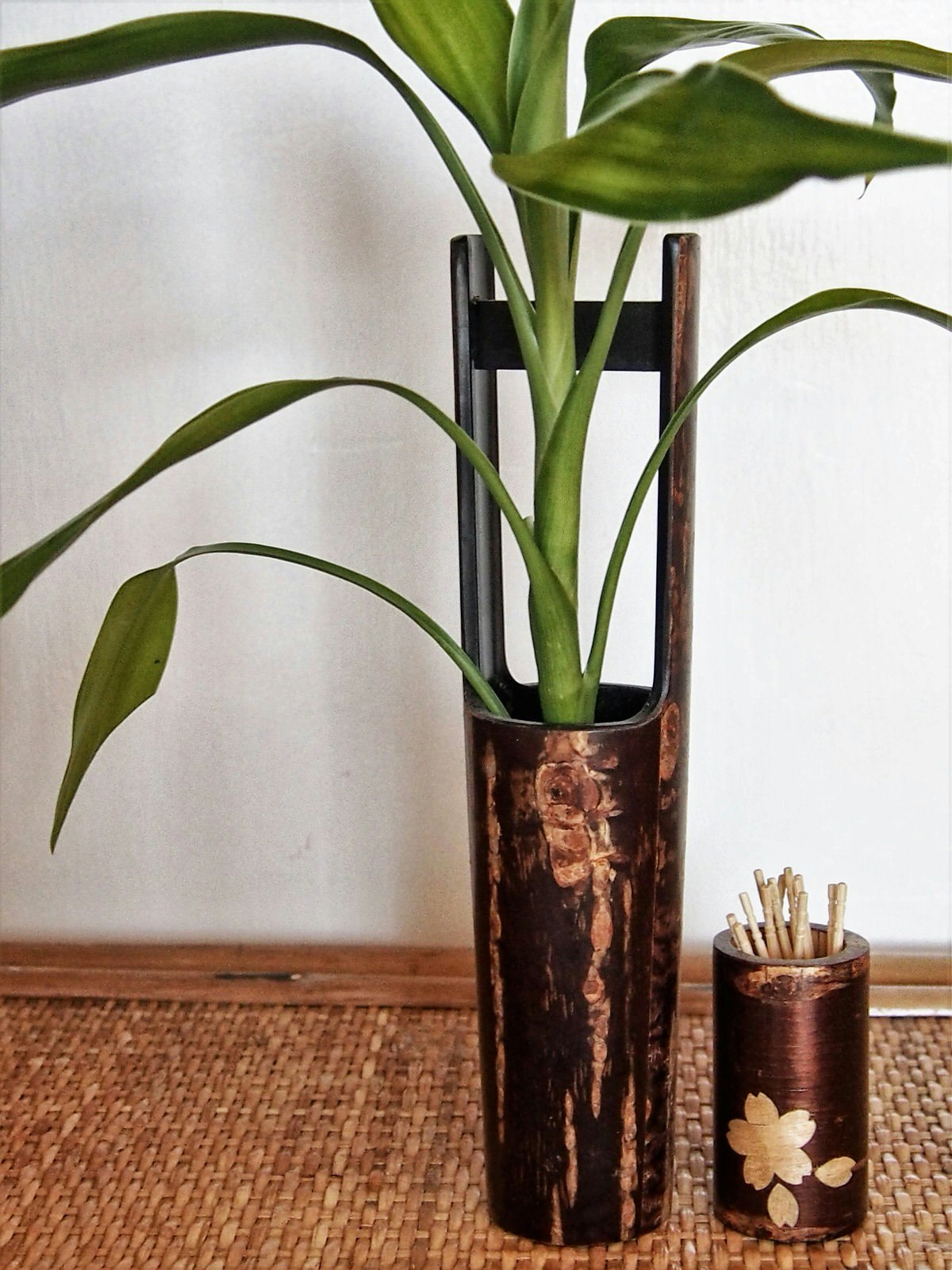Handmade in Tōhoku: traditional crafts of northern Japan
Jan 5, 2018 • 7 min read

Japan’s ‘deep north’, the largely rural Tōhoku region is home to craft traditions that have been handed down over generations. A trip to this little-visited swathe of the country offers a chance to see skilled artisans at work – and find a unique souvenir – just a train ride or two from Tokyo.
Papier-mâché tigers, talismanic hawks, cast-iron kettles and the always-popular kokeshi dolls are just a few of the handmade items travellers will encounter on an arty tour of northern Japan. Many artisans have workshops and studios that welcome drop-in visitors, making it easy to 'atelier hop' around the region. It’s best to call ahead (or ask your hotel to call) to confirm opening hours before dropping by.

Kokeshi dolls in Naruko Onsen
Kokeshi are simple, limbless wooden dolls decorated with various patterns including chrysanthemums, plum blossoms and stripes. They have traditionally been made in remote hot-spring villages, such as Tsuchiyu Onsen in Fukushima Prefecture, and Shiroishi and Zao in Miyagi Prefecture, where they are still made and have been since the Edo period (1608–1868). As with many folk toys, kokeshi were historically produced by farmers during the long winters to supplement their income. Originally for children, the dolls are now admired as elegant design pieces.

Naruko Onsen in Miyagi Prefecture offers multiple opportunities to visit studios to see woodworkers deftly manipulate the wood into kokeshi, like sculpting butter – to make the body only takes a skilled hand a few minutes. Third-generation artisan Yasuo Okazaki has 40 years’ experience and works out of his own studio. He says collectors find the demure facial expressions of the dolls ‘comforting and healing’. The dolls are experiencing something of a boom in popularity amongst urbanites, who make kokeshi ‘pilgrimages’ to various bucolic villages of the region.

Naruko Onsen also has a kokeshi museum with an expansive shop and an artisan booth – a small space where visitors can watch craftspeople work the lathe.
Naruko Onsen is about 45 minutes by train from Furukawa, which is connected to Sendai by regular and shinkansen (bullet train) services. The views on the Furukawa to Naruko Onsen stretch are particularly stunning in autumn.

Paper lanterns in Aomori Prefecture
While originally used as a light source in Japan, paper lanterns are mostly decorative nowadays, dangling outside bars and eateries, or displayed at matsuri (festivals). Lanterns are crafted all over Japan (downtown Tokyo is also home to skilled lantern makers), but Tōhoku is particularly famous for its massive nebuta lanterns, on display during the Aomori Nebuta Matsuri (first week of August).
In the hot-spring village of Kuroishi, Aomori Prefecture, Yuichi Mori makes opulently painted lanterns in the likeness of kokeshi dolls. Formerly a kite painter for 40 years, Mori uses large, bold brushstrokes on his work, with motifs incorporating peonies and mythological creatures.

His studio is located at the Tsugaru Craft Hall, 20 minutes by bus from Kuroishi Station. Visitors can watch him work, and buy smaller lanterns at his studio. At night, dozens of lanterns are lit up around the village, giving it a wonderfully ethereal atmosphere.
Kuroishi is about 90 minutes by train from Aomori city.

Ironware in Iwate
High-quality ironware has been crafted in Iwate Prefecture since the 1600s, when the area was known as Nambu after the ruling clan of the time; cast-iron items from this region are still referred to as Nambu Tekki (Nambu Ironware). Among the ironworks of the region, Iwachu, founded in 1902, is highly regarded for its tea kettles, cookware and other household objects. Boiling water in Iwachu pots releases small amounts of iron, which gives the water a soft, mellow texture, and is said to be beneficial for those who are iron deficient.

A section of Iwachu’s workshop is open to visitors. Here master craftspeople pour the molten iron, apply lacquer and embellish the molds with meticulous attention to detail. The shop adjacent to the studio has a huge array of kitchenware, pots and household items.
Iwachu is about 20-minutes’ walk from Sembokucho Station, one stop from Morioka Station (2½ hours by train from Tokyo).

Painted candles in Aizu
Aizu Erōsoku are colourfully hand-painted candles that have been produced in the Aizu region of Fukushima Prefecture for over 500 years. The candles are painstakingly crafted: the wicks are hand-rolled, and dipped into wax over thirty times, which gives the candles delicate ‘growth rings’ similar to those found in trees.
In the past, Aizu Erōsoku were used for Buddhist altars, so they utilise (vegan-friendly) plant-derived wax, which produces less soot. They are traditionally decorated with auspicious motifs and local flora, such as the Adonis flower, though more contemporary designs also appear. Yamada Shōten (11-29 Tateuma-machi, Aizu-Wakamatsu, Fukushima) is a studio a 10-minute walk from Nishi-Wakamatsu Station where visitors can shop and see candles being made.

Aizu (also called Aizu-Wakamatsu) is about 75 minutes by train from Kōriyama, which is connected to Tokyo by shinkansen. Visit Aizu in mid-February to catch the Aizu Painted Candle Festival, when thousands of candles light up the castle Tsuruga-jō and other spots around the city. Festival dates vary each year (9 and 10 February in 2018).

Cherry-bark craft in Kakunodate
Kabazaiku woodwork, made by applying strips of treated bark from the cherry tree onto items made from cherry-tree wood, is lauded for its lustrous veneer, smooth surface and rich colours. The craft is said to have been pioneered by a retainer of the ruling Satake samurai clan in Kakunodate, Akita Prefecture, in the 1780s.
Given the antibacterial, airtight nature of the bark, it was initially used to make items such as medicine and tobacco boxes, and containers for tea. Eventually, many samurais lost their status, became full-time artisans and created increasingly more sophisticated objects. The artisans were conscious of sustainability, using only a portion of the bark of tree, enabling it to quickly regenerate.

In the former samurai district in Kakunodate, Kabazaiku Denshokan (Cherry-Bark Craft Center) has numerous kabazaiku items on display, and artisans working on-site.
Kakunodate is on the shinkansen line, about three hours north of Tokyo.

Folk toys in Miharu
Hikoji is a folk-toy atelier located inside a majestic 400-year-old wooden house at the Deko-yashiki crafts village, Miharu, Fukushima. While Hikoji is famous for its wooden horses, it also produces an array of whimsical characters out of papier-mâché.
Hikoji specialises in Chinese zodiac motifs, daruma dolls (in the likeness of Bodhidharma, the founder of Zen Buddhism), and maneki-neko ('beckoning' cats).

According to artisan Daisuke Hashimoto, in the early days of the village during the Edo era, professional healthcare was not easily accessible, so people used these folk toys as a form of protection. While people still collect them as talismans, many of their animal motifs are also irresistibly cute.
Deko-yashiki is 10 minutes by taxi from Miharu Station, which is about two hours by shinkansen and train from Tokyo.
Talismanic hawks in Yonezawa
Sasano Ittōbori is a type of rustic amulet, carved from local wood types using a specialised cleaver. These amulets have a history stretching back over a thousand years in Yamagata’s Yonezawa, and require incredible dexterity to carve, as the elaborate form is sculpted from a single piece of wood.

While there are numerous motifs for the amulets, such as Buddhist deities, the most popular is the otaka-poppo (taka means ‘hawk’, and poppo is ‘toy’ in the indigenous Ainu language). It is thought that by using the strength of the hawk one’s luck will flourish.
At the Kanpu atelier (5742-1 Sasano-honcho, Yonezawa), about 30 minutes’ walk from Minami-Yonezawa Station, visitors can paint their own hawks (¥800 to ¥1000). Yonezawa is approximately two hours from Tokyo by shinkansen.
Those unable to make it to Yonezawa can also find the talismans at the museum-like Tohoku Standard Market, an expertly curated emporium of Tōhoku crafts in Sendai (opposite the train station).

A bit of everything in Morioka
For travellers wanting a participatory, family-friendly experience with a whole range of crafty options in one convenient centre, head to Handi-works Square in Morioka. This large complex has 14 small workshops and studios. At each studio, visitors can watch artisans at work, and also try their hand at making simple craft items.

Among the crafts are textile dyeing, pottery, and bamboo work, as well as traditional food workshop. Also on display is a full-sized magariya farmhouse – a fine example of traditional rural architecture, characterised by a pitched thatched roof and an attached stable. A spacious on-site shop sells over 3500 artisanal goods. To get there, take a bus (about 25 minutes) from Morioka Station.
Plan with a local




